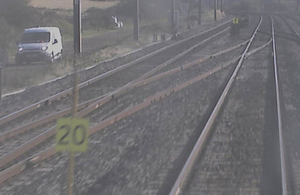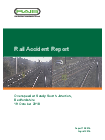Report 10/2019: Overspeed at Sandy South Junction, Bedfordshire
RAIB has today released its report into an overspeed at Sandy South Junction, Bedfordshire 19 October 2018.

Photo showing the 20 mph commencement board and the termination board for the emergency speed restriction (still taken from ffcctv footage from the incident train, courtesy of LNER)
Summary
At around 14:32 hrs on 19 October 2018, a London bound, London North Eastern Railway passenger train traversed a section of track at Sandy South Junction, where an emergency speed restriction of 20 mph (32 km/h) was in place, at approximately 121 mph (195 km/h).
The emergency speed restriction had been put in place at around 14:00 hrs the previous afternoon because a crack had been found in a crossing associated with a set of points.
The train driver had become unwell earlier in the journey. On experiencing worsening symptoms, the driver decided to take medication which he kept in his bag. He was reaching for the medication when the train approached the warning equipment associated with the emergency speed restriction. As a consequence of feeling unwell and reaching for his medication, he was distracted and did not reduce the speed of the train in response to the audible and visual warnings that he received.
The driver was not aware prior to starting his journey that there were any emergency speed restrictions in place on the route, although Network Rail had sent out a notice to all the affected train and freight operating companies to inform them that the speed restriction was in place. London North Eastern Railway’s control centre did not pass this message on to its drivers, in line with its then current procedures. These procedures had been in place since a Rule Book change in June 2008 when the requirement to notify drivers of freight and passenger trains of the presence of emergency speed restrictions was removed from the Railway Rule Book after a request from a freight operating company and an analysis by RSSB. This led to the committee responsible for the decision concluding that lineside warning equipment placed on the approach to a restriction to indicate its presence was sufficient notification for drivers. The RAIB has found that the information that this conclusion was based on did not cover all the factors that should have been considered and that the way the railway industry handled the Rule Book change was inconsistent.
Recommendations
The RAIB has made five recommendations, the first of which is addressed to train and freight operating companies to minimise the risk of drivers not being aware of speed restrictions in their route before commencing their journeys. The second is addressed to Rail Delivery Group and Network Rail, to look at available technologies to provide drivers with additional warnings of speed restrictions near to the location of the restriction. The next, addressed to Network Rail, is to consider the design of the emergency speed indicator to ensure it is conspicuous for as long as possible in bright sunlight and in shadow. The fourth is to London North Eastern Railway to train its drivers in the safest ways to divide their attention between the line ahead and things which may temporarily require some of their attention if it is not practical to stop the train. The last recommendation is addressed is to RSSB, to review the processes around the removal of existing rules from the Rule Book, and monitoring the consequences of such changes.
Notes to editors
- The sole purpose of RAIB investigations is to prevent future accidents and incidents and improve railway safety. RAIB does not establish blame, liability or carry out prosecutions.
- RAIB operates, as far as possible, in an open and transparent manner. While our investigations are completely independent of the railway industry, we do maintain close liaison with railway companies and if we discover matters that may affect the safety of the railway, we make sure that information about them is circulated to the right people as soon as possible, and certainly long before publication of our final report.
- For media enquiries, please call 01932 440015.
